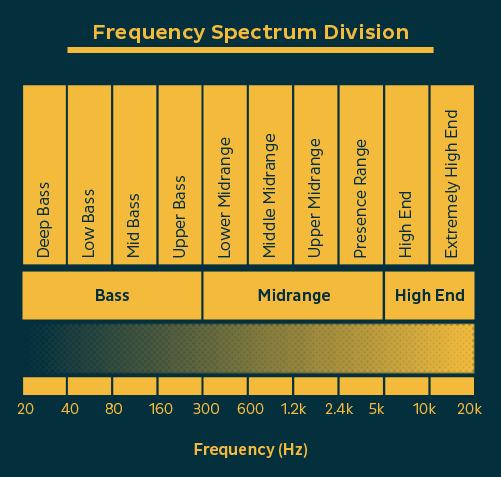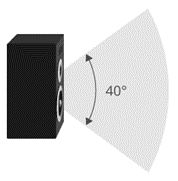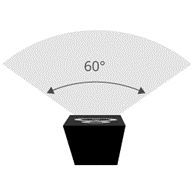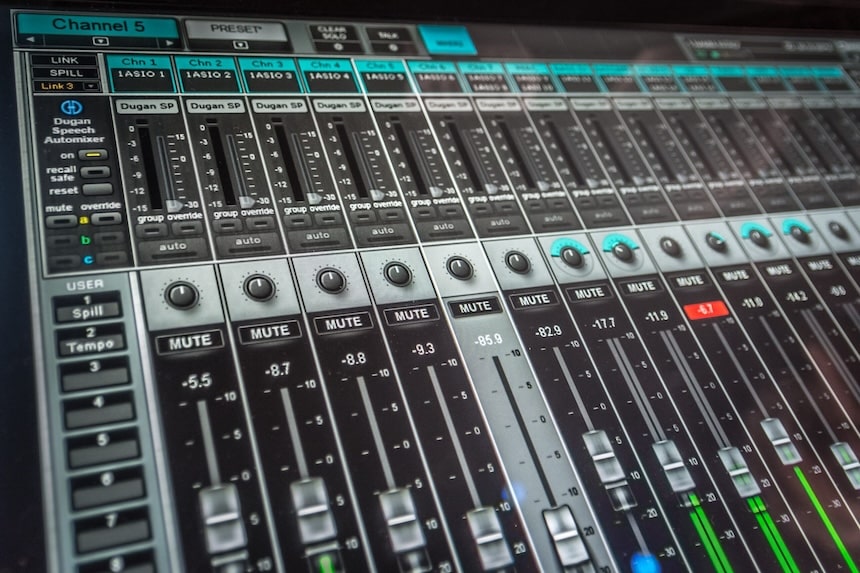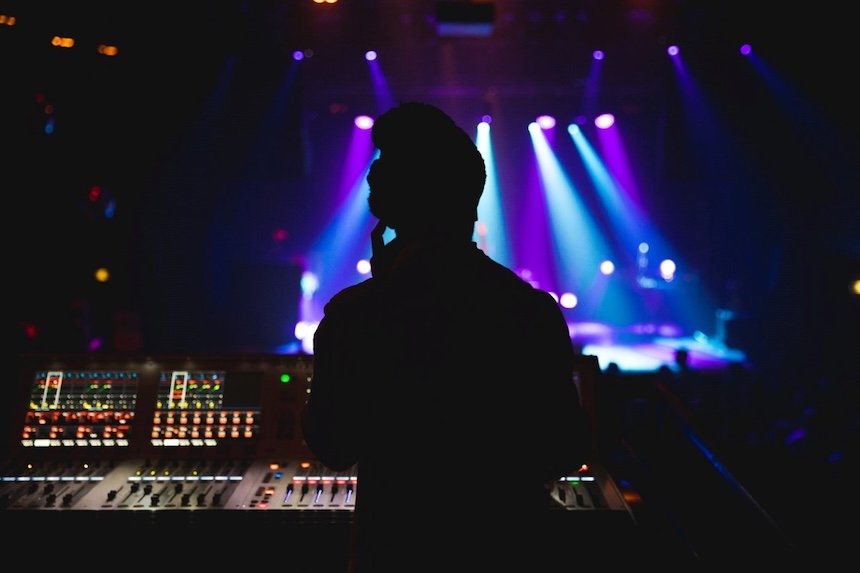For bands, orchestras, and singers, sound is the most important consideration for their performance. Their goal is for their concert sound to be the best it can be when they perform for live events. Live events are not like a recording studio where they can control how they sound to a very high degree with sound processing that corrects off-key and other issues. That’s why many performers can never live up to their recording studio sound when playing live.
The goal for venues and companies providing sound production services is for the audience to hear the performance clearly based on the venue’s acoustic properties, audience size, and the scale of the event. That’s the reason that many entertainers bring their own sound engineer and mixing board to events. It’s worth the cost to them to help assure that the concert sound is engineered right for their instruments and voices.
Audio Setup for Concert Sound
Setting up a concert sound system for a performance requires taking into consideration a range of strategic and technical elements when planning the audio components of such a sound system.
Factors to consider for your event to determine your audio setup needs:
- Size and nature of the performance space
- Acoustic properties
- Expected attendance
- Sound ordinance restrictions
- Artist audio requirements and the type of music being performed
- Overall theme of your event (Is it a music-focused festival or is the music intended to be background noise? Etc.)
The concert sound system components are based on coverage requirements and the size and nature of the venue. While the input side of the sound system may likely be the same for different size events, the output side (amplifiers and speaker system will vary greatly by the coverage requirements, size of audience and the acoustic properties of the venue.
For an acoustic performance or for genres where bass and kick drum aren’t key in front of an audience of a couple of hundred people, your audio setup can be as simple as two full-range speakers and a mixer set up. Smaller party bands will often carry this type of audio setup with them to events.
Contrast that with an outdoor or arena concert that involve tens of thousands in the listening crowd. In these situations, you will need as many as 40 or more speakers. With either setup the audio engineer or sound tech will need to tweak the audio for acoustics for better audio quality. An advantage of outdoor venues is that they usually take place in a relatively open area eliminating the need for most acoustic tweaking. However, the lack of reflecting surfaces will require a more powerful sound system to cover the same area.
Concert Sound Involves Understanding the Following:
- Acoustics
- Sound System Components
- Speakers
- Amplification
- Sound Board
- Equalization Process
Understanding Concert Sound Begins with Venue Acoustics
Music venues spend a lot of time addressing the production audio needs for their events. Whether it’s an outdoor temporary stage, a nightclub venue, theater, performance center or even a concert hall, a lot of effort and resources are directed at the PA system with the right mixing board, amplifiers, and speakers for the performances to take place there.
What sometimes is lost in all this preparation are the acoustic properties of the performance site. One of the most recent examples of this failure was the opening of U.S. Bank Stadium in 2016. One of the early concert events was a Metallica concert. The fan experience at that concert was disappointing because of the poor acoustics of this brand-new stadium. Millions of additional dollars were spent after it opened to address the acoustical problems with the facility.
This is a perfect example of addressing sound needs without addressing the equally important acoustic requirements for the venue. No matter what the size of music venues or performance areas, you should be looking at creating a great fan experience. Venue acoustics should be a crucial part of planning for concert events.
Understanding How Acoustics Affect Sound is Fundamental to Planning Music Venues Performance Spaces
The fact that acoustics is a branch of physics concerned with the study of sound can be intimidating to those who provide sound for performances at venues. Some basic understanding of the physics involved can help us provide better concert sound for events.
Audio Versus Acoustics
When we refer to audio, we are generally talking about the electronic representation of an acoustic signal as we create, amplify, store and broadcast sound. To hear the audio, the signal must be turned into acoustical waves. Sound, like light, travels in waves thought air or another medium. We “hear” sound when the sound waves enter our ear. It causes the ear drum (tympanic membrane) to start vibrating. The vibration is amplified as it moves through the middle and inner ear. In the inner ear the vibrations are finally transformed into electrical energy that travel via auditory pathways to the parts of the brain involved in what we “hear” as sound.
If we want to understand how sound affects a listener, we need to analyze the three components involved. They include the source of the sound, the pathway to the receiver, and the receiver itself. During concerts, the receiver is most often a human listener in the audience. To change the sound volume or quality means manipulating one of these three elements.
For example, If you wanted to increase the sound volume in music venues, you can increase the gain on the source or you could move the receiver closer to the source. You can also remove things that absorb sound in the pathway to the receiver as well.
Defining the Acoustics of an Entertainment Space
When a speaker, singer or musician produces concert sound, the sound waves are projected outward from the source and get absorbed or reflected by the surfaces they encounter along the way to the receiver. Acoustical properties or the acoustics of an area are the way the sound waves interact with the music venues spaces’ environment.
The Ways in Which Sound Waves Interact with Their Environment
Except for a large empty field, a so-called free field environment, where the only thing that affects the path is distance, other spaces have objects contained in them that affect the path from the source to the receiver. As sound runs into things, it is affected in several ways. Sound waves, like light waves tend to travel in a straight line.
Absorption
Most things sound waves impact will absorb some amount of the sound. Absorption may involve sound waves passing through the material or may even cause the sound waves to be converted to heat or another form of energy as it’s absorbed. Be aware that the amount of sound wave absorption versus reflection is frequency dependent for a given material. That means that low frequency absorption may be larger or smaller than high frequency sound wave absorption.
Reflection
When sound waves encounter an object at least some of it reflects. The amount of reflection will be determined by the angle of incidence and the material it impacts. It behaves much like light in that the angle of incidence equals the angle of reflection, much like the way a billiard ball bounces off the side of a pool table. A large, flat surface functions like a mirror for sound waves. In a typical indoor listening environment, we are hearing sounds that have reflected off numerous objects and surfaces,
 Diffusion
Diffusion
When sound waves encounter a reflective surface that is uneven, the waves may reflect in many directions at the same time because of all the smaller surfaces that are found on a surface that is not flat and smooth. The waves have many angles of incidence in such a circumstance, generating many angles of reflection.
Diffraction
Sound waves can bend to go around objects. The bending of sound waves is called diffraction. It happened when the wavelength of the sound wave exceeds the dimension of the object. This enables some of the sound waves to avoid being reflected. Since low sound waves have larger wavelengths, the lower the frequency the more likely they will diffract.
 Refraction
Refraction
Refraction typically does not impact the sound waves generated during concerts or speaking engagements. It refers to sound bending because of the speed change that results from traveling through a different medium or temperature environment.
Indoor Acoustic Issues
The acoustics or acoustic properties of music venues is the behavior of sound waves within them because of the things they encounter in its pathway between the source and the receiver in the ways explained above. Venues need to optimize their acoustics, considering both the properties of the performance space but also the type of audio that will be played there. Space issues include the size and shape of the room, the materials used for both the structure and furnishings, and the size and configuration of the expected audience. The optimal acoustics are different for an acoustic performance as opposed to a rock band performance. Most rooms are set up as the best compromise for the kinds of sound that will take place in it.
Reverberation: How Much is Right for Music Venues?
Reverberation is the persistence of sound after the original source of it has stopped. It’s caused by multiple reflections from various surfaces, such as walls, furniture, etc. These multiple bounces of the same sound in essence reflect the same sound multiple times. While both reverberation and an echo describe a sound that persists after the source stops, an echo is a little different from reverberation in that it’s a distinct reflection of the exact source sound while reverberation is reflecting different bounces from various surfaces of the source sound.
Reverberation is multiple echoes emanating from reflective surfaces in the listening space. These reflections build up as the “echo” bounces from one hard surface to another gradually being absorbed over time by other absorbing objects in the space. It’s the reason the sound from an event held in a gymnasium or school auditorium that you hear is so much different than the original source voice or music.
The key to reducing reverberation is to add sound-absorbing materials to the space. The more absorption, the less reverberation will occur. The sound will decay much faster as we increase the sound absorption properties of the room.
How Much Reverberation Do You Need?
Reverberation is measured by a parameter called reverberation time. It’s usually defined as the length of time it takes for the original sound to decay to about 60 decibels from the initial level. A longer time delay impacts what the listener hears. Instead of hearing the direct sound waves, the listener hears both the direct sound and the reflected sound waves. Excessive reverberation causes the sounds to run together, causing the original sound to become muddy and garbled.
Reverberation is not bad. Music often benefits from differing amounts of reverberation. The right reverberation time can dramatically enhance the sound quality of performances. Music venues prefer longer music reverberation time because the reflected sound waves help blend the music in a more pleasant way as it reached listeners’ ears.
Acoustics are not only important for musical performances, but are important for venues that host weddings, corporate events, private parties, tradeshows, etc. In these cases, the source of the sound is the conversations taking place among the guests attending the event. Because of the volume of conversations and the fact that people are facing many different directions, the venue needs to treat more areas of the event space with sound-absorbing material. Shorter reverberation times are important in speech-oriented spaces. The less reflected sound waves makes it easier to understand the speaker clearly.
Unless your music venue was designed from the ground up with acoustics in mind or is a large open space, you should make every effort to optimize the acoustics of the space for concert sound. This is especially important when concert organizers turn another kind of space, e.g., bar, restaurant, parking lot, warehouse, etc. into a concert venue. It’s worth the investment of an acoustic engineer to help you optimize the acoustics for your performance space. You want a place where people will keep coming back because they love the sound at your events.
Concert Audio Setup: The Sound System
A concert sound system receives microphone and musical instrument inputs, processes and amplifies them and then outputs them through the speaker system. For concert audio, the main components of a sound system consist of speakers, amplifiers, and a sound board.
Speaker Issues for Concert Sound
- Frequency Response,
- Amplitude or Sound Pressure Level (SPL)
- Dispersion
Frequency Response:
Frequency measures the number of sound vibrations in one second. It’s measured in Hertz (Hz). This relates to how low or high pitched the vibrations are. The more the vibrations (measured in Hertz), the higher the pitch sound is. We use both Hz and KHz (1000 Hertz) to show frequency ranges.
We hear by sensing the vibrations generated by sound waves in the air or other environments. The middle and inner ear translate these air vibrations into signals our brains can interpret. The normal human hearing frequency range is 20 Hz to 20,000 Hz or 20 kHz. This is the range for a healthy young person. The younger you are the better you hear. Infants can actually hear frequencies slightly higher than 20 kHz. As we age, we lose hearing first from the upper frequencies. A middle-aged man is more likely to have an upper range around 14 – 17 KHz range.
Low frequency noise, the frequency range from about 10 Hz to 200 Hz is especially problematic for many people. They are especially sensitive to such low frequencies. While a bass’ range may be from 31 Hz to 400 Hz, most bass playing occurs between 40 Hz to 200 Hz. The bass and the kick drum tend to play during most of a song and they share a lot of frequency ranges, especially 50 to 100 Hz.
A full range speaker has a frequency response of 60 Hz to 18 KHz and is fine for many musical instruments and genres of music. For genres where the kick drum and bass are key, you will need to complement them with subwoofers for the additional punch required. Subwoofer extends the frequency response down to 45 Hz or lower and will allow the full-range speakers additional headroom and increased output. For bands using a five or six string bass, the subwoofer speakers may need frequency responses down to 31 Hz.
Sound Pressure Levels (SPL) or Amplitude
Amplitude measures a sound’s pressure or forcefulness. The more amplitude a sound or noise has, the louder it is. We often refer to this as gain or volume. The unit of measure of sound pressure level is the decibel (dB). Decibels use a logarithmic scale. That means that as the number of decibels increases, the sound level increases rapidly or exponentially. We will confine the use of the decibel to sound pressure levels although it is used to measure the intensity of other things as well.
While the “normal” hearing audible amplitude range of a healthy young person is from 0 to 180 dB, anything over 85 dB has the potential to damage hearing depending on the frequency and length of time exposed to those sound levels.
The logarithmic nature of the decibel scale means that a very large range can be denoted by a useful number. For example, every increase of 10 dB on the decibel scale is equal to a 10-fold increase in sound pressure level (SPL). Near silence is expressed as 0 dB. A sound measured at 10 dB is 10 times louder. If a sound is 20 dB, that’s 100 times louder than near silence.
To recap, the difference is the sound coming out of a speaker at 90 dB is ten times louder than the sound coming out of a speaker at 80 dB! For example, 120 dB SPL may be clearer than “a trillion times more intense or louder than the threshold of hearing” at 0 dB.
A normal conversation is about 60 dB, a loud lawn mower may reach 90 dB and a loud rock concert can reach 120 dB or more. The effect of loud noise on hearing varies among people. The effect may vary by the frequency of sound to which they are exposed as well. In general, sounds above 85 dB are harmful, depending on how long and how often you are exposed to them. Such exposure may lead to hearing loss. Most occupational workplace noise regulations prevent employees from being exposed to noise greater than 85dB over the course of their workday. Leisure noise such as found at concerts is less studied and regulated.
The loudness of a sound is also determined by the sensitivity of the ear. The human ear is more sensitive to some frequencies than to others. The volume we receive thus depends on both the amplitude of a sound wave and whether its frequency lies in a region where the ear is more or less sensitive.
Children under 13 are even more susceptible to hearing issues with loud noise. That’s because they have better hearing than adults. It’s very important that hearing protection measures be taken for this group when exposed to high concert sound levels.
Concert Speaker Setup
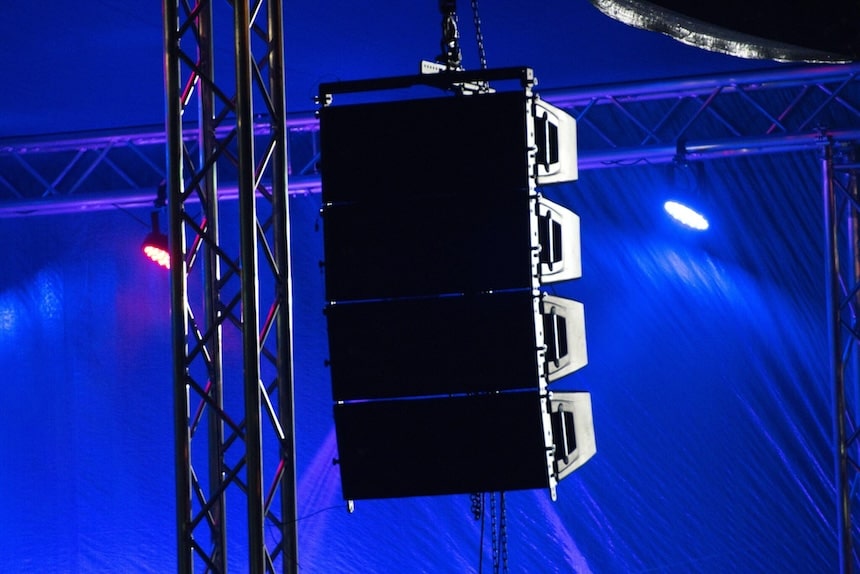
Speaker SPL
The sound pressure level (SPL) of a speaker is a measure of how loud the speaker is at a given distance. The sound pressure level will be reduced by 6 dB with the doubling of the distance from it. So, a speaker with 135 dB output at 1 meter would have an output of 129 dB at 2 meters and a 123 dB output at 4 meters and so forth. 1 Meter is used, because that is the standard for Maximum SPL of a speaker in the specification sheet.
To maximize the SPL, you can add additional speakers. Each additional speaker will add 3 dB output. By adding another speaker to a 135 dB peak out speakers, you increased the output to 138 dB.
In a nutshell, the SPL output and number of speakers will determine how loud the sound will be at various distances from them. Remember that practically speaking, a one dB power gain is approximately 26%; a 3 dB is roughly twice the power gain, and 10 dB is about ten times the power gain.
Speaker Dispersion
Most loudspeakers have a sound projection pattern or dispersion pattern. Dispersion refers to waveguides, a portion of the speaker, usually a horn-like shape, primarily attached to the high-frequency driver or some boundary effects sometimes integrated into the speaker cabinet design. The waveguides do what you can probably guess by the name. They guide the sound waves to determine the coverage pattern of the speaker.
Low frequencies are omnidirectional, so when we set a loudspeaker on the floor, we effectively halve its radiating space at low frequencies. This produces an additional 3 dB of output (double the power) in the remaining coverage space. Speakers with a broad dispersion pattern create a larger sound field and a more consistent listening experience. A broader dispersion also means the speakers are more forgiving with where you place them.
How wide an areas a speaker will cover versus how high it covers is generally related to the physical size and shape of the speaker itself. However, sometimes speakers can have a variety of different coverage angles.
Dispersion is the direction the sound is projected both horizontally and vertically from the speaker. Knowing the speaker dispersion is important to determine speaker placement. The placement goal is to provide coverage to the entire audience. Today’s speakers allow for many speakers to be placed together in a tight-knit group or array, which allows for coupling with reduced interference between speakers.
The vertical dispersion of the speakers will determine how high the full-range speakers will need to be placed to provide the right sound coverage for the audience. There are several ways to configure the height needed for coverage including stacking speakers, utilizing speaker stands, scaffolding, or using trussing to achieve the height required to provide needed coverage to the full audience.
The higher the speaker, the further the sound will travel. It it’s too high, there will be a loss of impact in the front as the sound goes over their heads. If the speakers are not high enough, the sound may be uncomfortable for the people immediately in the front of the stage.
The main concern with horizontal coverage is ensuring you reach all the audience on both sides of the stage with minimal overlap. The more the speaker drivers overlap, the more likely you will produce phasing from sound wave interference. Phasing can cause hotspots, areas that are louder than other areas, or cancellation, where there is not enough sound.
Vertical Dispersion Horizonal Dispersion
Sound Amplifiers
An audio amplifier is a device that turns the low voltage signals from your source equipment received via line or mic inputs into a signal with enough gain to be used to power speakers. There are two functions of amplifiers used in a concert sound setup. The first includes collating and selecting multiple inputs and selecting the required level of gain and is generally referred to as the preamplifier. The second does the ‘heavy lifting’ and adds the gain to the signals to be used to power speakers. This is the power amplifier.
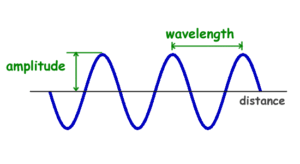
When selecting amplifiers for a concert sound setup, the important specifications to consider include:
- Desired power output or SPL
The desired output to fill a venue with loud, clear sound depends on the type of music being performed as well as the venue space acoustics. Different applications require different ranges of power based on the desired loudness, speaker continuous power rating, and the loudspeaker’s sensitivity.
The higher the sensitivity rating of a speaker, the louder it will play with a certain amount of wattage. Loudspeakers with high sensitivity need less power than loudspeakers with low sensitivity. Large speakers used for concerts have a typical sensitivity of 110 dB.
- Signal to Noise Ratio:
Signal-to-Noise Ratio, or SNR, is essentially a measure of clarity. It tells us how much clearer the music is compared to any background noise in the system. It compares the level of signal power to the level of noise power. It’s most often expressed as a measurement of decibels (dB). Higher numbers generally mean a better specification since there’s more useful information (the signal) than unwanted data (the noise). The higher the SNR, the less interference you’ll have from background noises like hums, hisses, or pops. Concert amplifiers should be in the 100 dB SNR range.
- Total Harmonic Distortion (THD)
Total Harmonic Distortion compares the input and output of audio signals, with the difference in stages measured as a percentage. The percentage represents the harmonic distortion or deviation of the output signal. Lower percentages are better. Each component of the audio system adds some level of distortion, so it’s prudent to assess numbers to maintain audio output purity. However, Total Harmonic Distortion is not as important a specification these days since most values are often less than 0.005 percent.
- Nominal Impedance:
Think of impedance as a complex form of AC resistance. In the ideal situation, the impedance of the speakers and amplifiers should match to transfer the maximum power from the source to a destination speaker. This situation refers to as having matched, or balanced, impedances Matched impedance provides the optimum amplifier power level which is 50% for the total power output required. Mismatched impedance can lead to excessive power use, distortion, and noise problems.
How Much Power Do You Need?
Crown Audio has a calculator that determines the amplifier power required to achieve the desired SPL at a certain distance. It also accounts for the number of dB of amplifier headroom needed for audio peaks. The following link goes to Crown’s power calculator: Calculator
Take Away
A high-quality amplifier used for concert production with matched impedances will provide the power needed (gain) while minimizing noise and distortion while delivering a linear frequency response, i.e., every frequency is equally represented at output needed.
The Role of the Sound Board
The mixer, equalizer, or sound board is the hub or traffic director of all the audio components of a performance. It’s a device that combines and routes multiple inputs to a common output. Inputs include microphones, line-level instruments, RCA components like DJ turntables, and other auxiliary sound sources. A professional mixing console ranges from 8-124 inputs, often called channels.
Why so many? In live concert sound you may have many instruments and vocalists and that’s why many inputs or channels becomes a necessity. A guitarist, a bass, a keyboardist, each vocalist takes a separate channel. A drummer usually takes up a channel for each drum and cymbal, averaging 8 inputs alone for a drummer. Try mixing a large band or orchestra in and you can quickly see where 124 inputs will come in handy!
Each individual input channel can be live or muted with extremely detailed controls of how that specific channel sounds and where it is output (to which speakers).
The sounds board’s role is to:
- Provide the necessary connections for various sound sources through its input channels.
- Allow the sound engineer to blend, or “mix,” all audio signals together and route them to a main output, i.e., speakers for a concert.
- Act basically as a level controller or equalizer for individual frequencies. It makes frequencies quieter or louder.
Sound Board Placement for Concerts
The front of house (FOH) equalizer or sound board has flexibility when it comes to placement. Generally, it’s placed between the speaker system so the FOH sound engineer can hear both speaker arrays equally. Some offset the console to the side of one of the speaker arrays to provide better viewing for the audience.
The FOH mixing console should be placed from two to four times the distance from the stage as the distance between the speaker arrays. For example, if your speaker arrays are 50 feet apart, then the console can be placed between 100 and 200 feet above the audience so that the audience doesn’t block any of the sound from the sound engineer’s ears.
The placement of the FOH console is also impacted by the type of music being mixed. For example, the console for a folk music performance will be placed closer to the stage than one for a heavy rock outdoor performance. Be aware that these are only guidelines, and you will find FOH mixing consoles at various locations at different events.
Equalization (EQ): Obtaining the Best Sound Quality During Concert Audio Setup
During sound check before a performance, the various audio sources from instruments, microphones, and auxiliary devices are assigned an input channel on the sound board. Each of these input channels are then manipulated to provide quality sound to the audience.
Equalization is the process of adjusting the amplitude or gain of specific frequencies to allow the audience to hear the sound the way the artist intends for them to hear. An equalizer or sound mixing board is basically a level controller for individual frequencies. It makes frequencies quieter or louder.
Most musical instruments and even human voices are defined by the range of notes they can make, thus, for instance, a female soprano is expected to be able to output maximum power (frequently also referred to as singing) in a certain pitch range This range corresponds to 262 Hz to 1047 Hz although some sopranos can go lower and higher than this range. So, if we want to pull out a soprano voice from the background these are frequencies we would concentrate on when equalizing. see here if you want to learn about frequency ranges of musical notes and instruments.
Fundamental Concert Input Frequencies
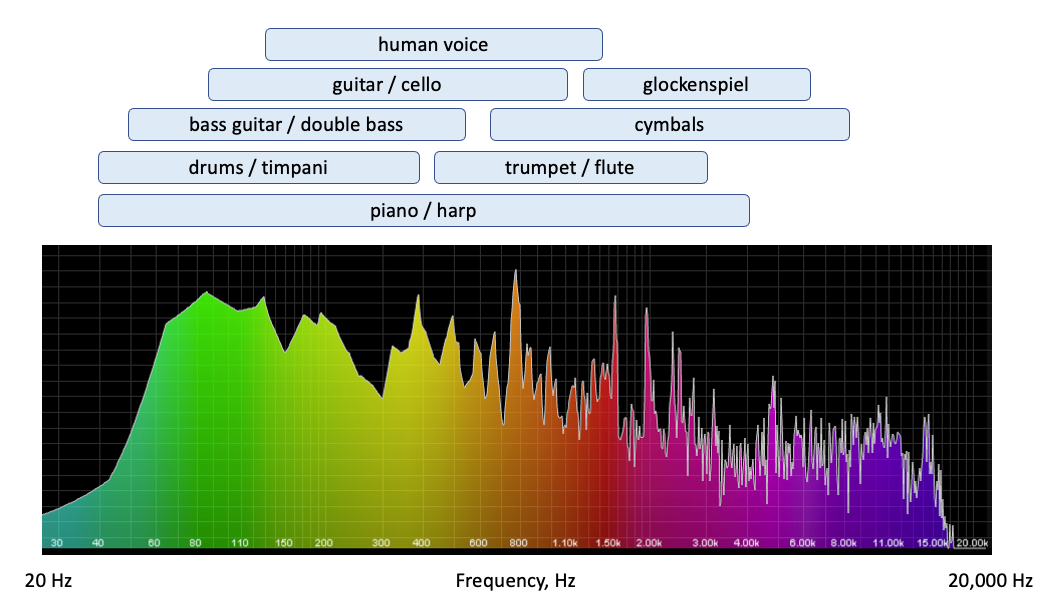
This is only a basic introduction to the much more complex subject of equalization
Conclusion
The audio setup for concerts is a complex undertaking, matching the audio system’s components to the size and acoustical properties of the performance venue, the size of the audience, the distances involved for the sound to reach its furthest members, and the nature of music being performed. The resulting sound is the result of having the right speakers, amplifiers, and sound board equipment for the event and the skill of the sound technician in equalizing the various frequencies to match what the artists’ want the audience to hear, and the acoustical properties of the venue. When these come together, the audience will hear the best sound possible and will enjoy the music as it was meant to be heard.
Related Posts:
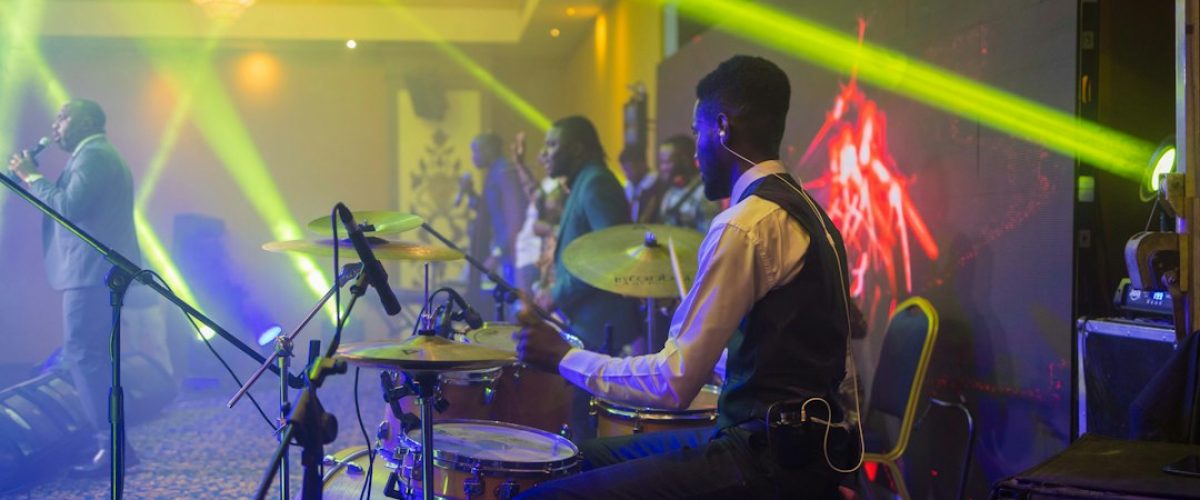
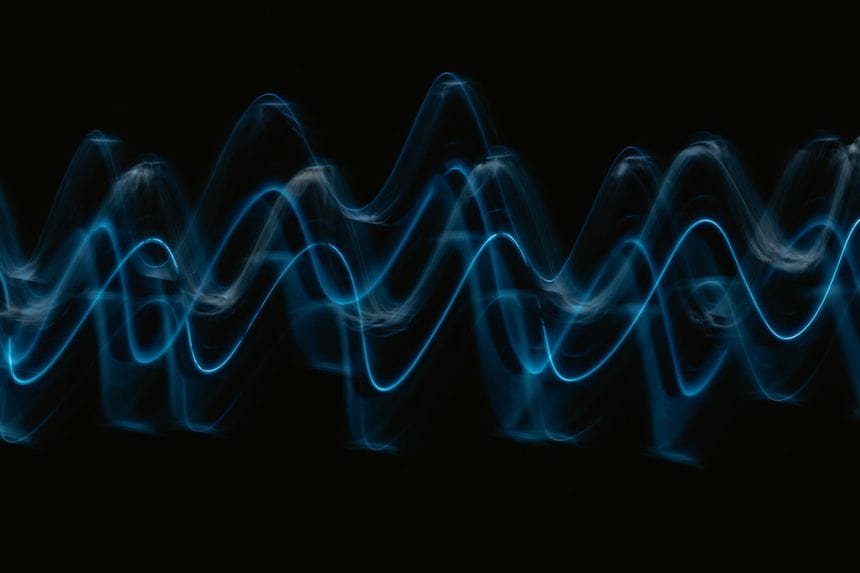

 Diffusion
Diffusion
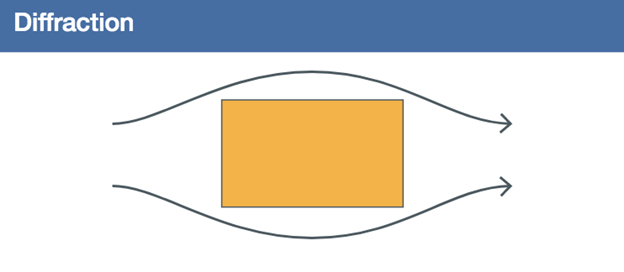 Refraction
Refraction
